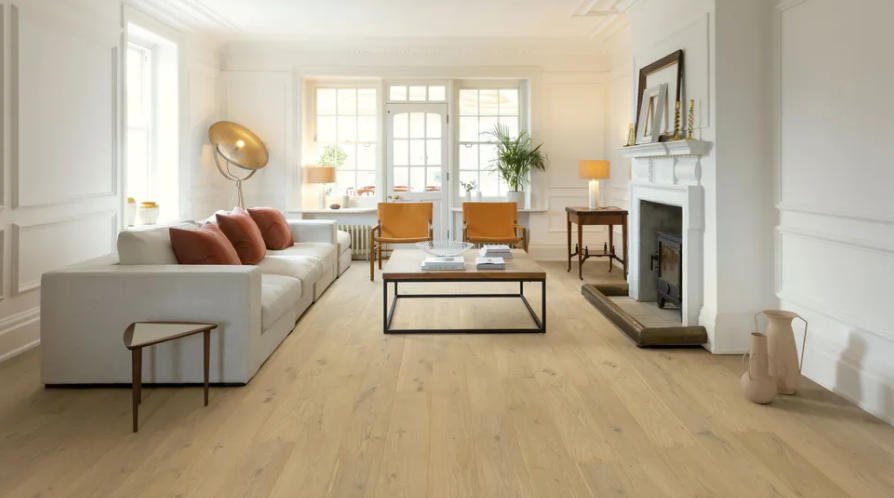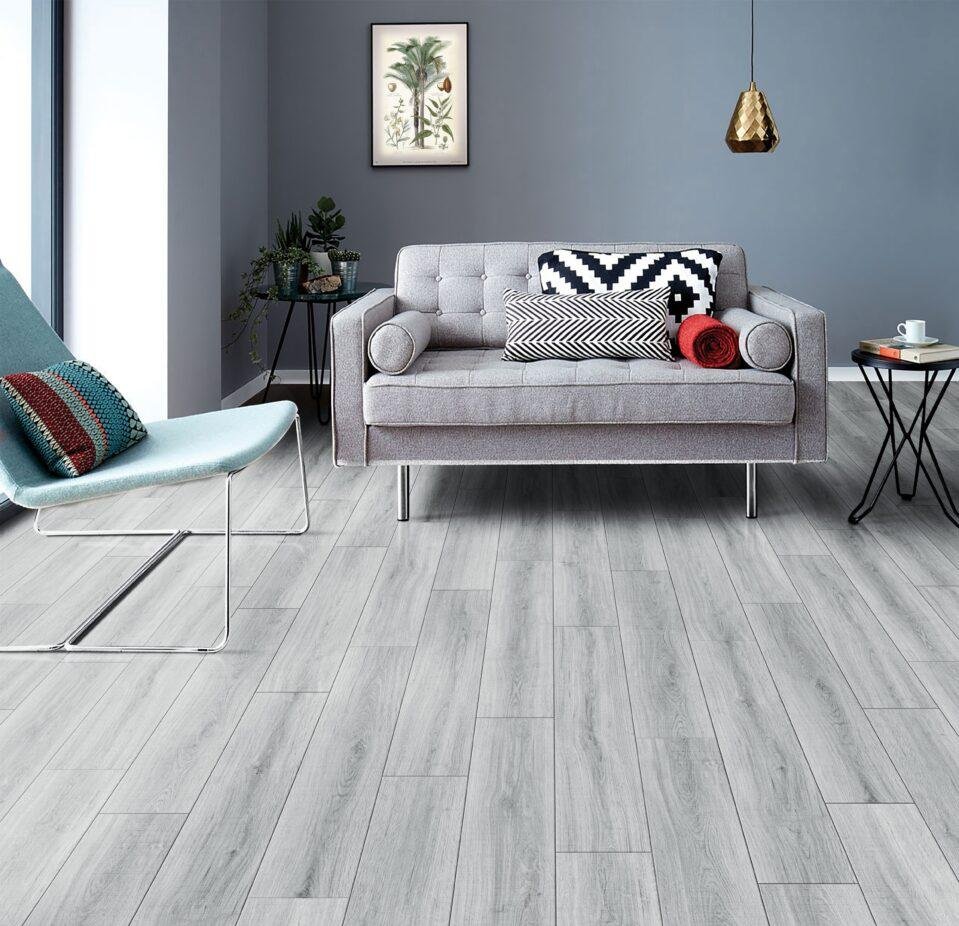
Laminate flooring has come a long way. Gone are the days when a single spill could ruin it. Now, it’s a favorite for folks who want the warm look of hardwood but need something tougher. Life gets messy quick—think spilled coffee, muddy boots, or a dog knocking over its water bowl. So, how much moisture can water-resistant laminate handle? Let’s break it down, explore what makes it tick, and figure out where it shines—and where it doesn’t.
Why Water-Resistant Laminate Matters
Your home’s a busy place. You step outside, maybe light up, and track in rain or dirt. Or you’re chatting with friends, and oops—there goes your drink. Old-school laminate couldn’t handle that. Water-resistant laminate, though? It’s built for real life. It’s not just about surviving a stray spill. It’s about cutting you some slack when chaos strikes.
This flooring’s made for people like you—folks who don’t have time to stress over every mess. Picture wet shoes from a rainy day or a soda spill during your morning rush. Water-resistant laminate shrugs it off. But it’s not bulletproof. Knowing its limits helps you choose wisely.
How Water-Resistant Laminate Works
Laminate flooring isn’t one solid piece. It’s a layered setup, each part working to keep water out. Here’s the rundown on how it does its job.
The Four-Layer Defense
Think of laminate like a club sandwich. Each layer has a role in fighting moisture. Here’s how they stack up:
Wear-Resistant Layer: The top layer’s a beast, often packed with aluminum oxide. It’s tough as nails, resists scratches, and handles spills like a champ. It keeps your floor looking good, even when life gets sloppy.
Decorative Layer: This is the eye-candy part. It mimics oak, walnut, or whatever vibe you’re going for. Sealed with resin, it blocks water from sneaking through.
Base Material Layer: The core’s where the magic happens. Usually, it’s high-density fiberboard (HDF). Some brands use stone-plastic composite (SPC) for extra moisture resistance. This keeps the floor from swelling or warping when wet.
Balance Layer: The bottom layer keeps things stable. It stops moisture from creeping up, like from damp concrete in a basement.
What Makes It So Good at Beating Moisture?
Water-resistant laminate has stepped up its game. Here’s why it’s better at handling water:
Tight Locking Systems: Old laminates had gaps between planks. Water would slip in. Now, click-lock systems fit like a glove. They create a tight seal to keep moisture out.
Sealed Edges: Many laminates have water-repelling sealants on plank edges. These stop water from seeping into seams.
Slick Coatings: Special surface treatments make spills bead up. You’ve got time to grab a towel before damage sets in.
Tougher Cores: Modern HDF or SPC cores are denser than older ones. They’re less likely to puff up, even after prolonged exposure.
Take a high-quality laminate with an AC4 rating (on a scale from AC1 to AC5). It can handle heavy foot traffic and occasional spills without breaking a sweat. Tests show top-tier laminates can sit with surface moisture for up to 24 hours without issues. But don’t test that limit too often.
Where Water-Resistant Laminate Shines

Every room’s got its own vibe. So does every laminate. Here’s where water-resistant laminate really stands out in busy homes:
Kitchens: The Spill Central
Kitchens are chaos zones. You’re cooking, maybe stepping out for a smoke, and then—bam—coffee or pasta sauce hits the floor. Water-resistant laminate can take it. Its sealed edges and tough surface laugh off daily messes. Wipe it up quick, and you’re golden.
Living Rooms: Your Kick-Back Spot
Your living room’s where you unwind. Maybe you’re sipping a beer or lighting up with friends. A spilled drink or a pet’s water bowl mishap? No big deal. Water-resistant laminate’s durability makes it ideal for these high-traffic hangouts.
Laundry Rooms and Basements: Tread Lightly
Thinking about laminate for a laundry room or basement? It can work, but choose carefully. Some laminates are built for higher moisture levels. Others only handle surface spills. Check the specs for E0 or E1 environmental grades. These ensure low formaldehyde and solid water resistance.
The Limits of Water-Resistant Laminate
Let’s clear the air: water-resistant isn’t waterproof. Leave a puddle sitting for hours, or let your basement flood, and even top-notch laminate might buckle. Here’s what to watch for:
Time Matters: Most laminates can handle spills for a few hours. But let water sit for 24 hours or more, and it might creep into seams and cause swelling.
Skip the Bathroom: Showers and tubs create too much standing water. Laminate can’t keep up. Go for luxury vinyl plank (LVP) or tile in those spots.
Installation’s Key: A sloppy install—like skipping expansion joints or laying on an uneven subfloor—lets moisture sneak in. That’s a recipe for trouble.
Comparing Water-Resistant Laminate to Other Flooring
Not sure if water-resistant laminate’s your best pick? Here’s how it stacks up against other options:
Flooring Type Water Resistance Cost (per sq. ft.) Durability Maintenance
Water-Resistant Laminate Decent (surface spills) $2–$5 Solid (AC3–AC5) Easy
Luxury Vinyl Plank (LVP) Fully Waterproof $3–$7 Tough Super Easy
Hardwood Poor $5–$12 Moderate High
Ceramic Tile Fully Waterproof $5–$10 Extremely Durable Moderate
Real-Life Scenarios: How Laminate Holds Up
Imagine this: It’s raining buckets outside. You come in from a quick break, tracking wet footprints across your entryway. Water-resistant laminate doesn’t flinch. Its sealed edges and slick coatings keep water on the surface. Or picture a poker night with buddies. Someone knocks over a beer. You grab a cloth, wipe it up, and the floor’s fine. That’s where this stuff earns its stripes.
But here’s a warning. A buddy of mine slapped laminate in his basement without checking its moisture rating. A small pipe leak turned his floor into a warped mess. Lesson learned: match the product to the room. Always read the fine print.
Why Choose Lanhe Flooring?

When you’re shopping for water-resistant laminate, Lanhe Flooring’s a solid bet. Based in Jinan, China, Lanhe makes high-quality laminate that’s stylish, tough, and budget-friendly. Their floors come in patterns like oak, ash, and walnut. You can pick thicknesses from 6mm to 12mm and abrasion classes up to AC5 for heavy use. Lanhe’s products meet E0 and E1 environmental standards, keeping formaldehyde emissions low for a safer home. Plus, their customization options let you design a floor that screams you—perfect for anyone wanting a space that matches their style.
Conclusion
Water-resistant laminate is a game-changer. It handles spills, muddy shoes, and the chaos of daily life while keeping that hardwood look you love. It’s not perfect, though. Wipe up messes fast, and don’t expect it to survive a flood. With Lanhe Flooring’s durable, stylish options, you can create a home that’s practical and packed with personality. Ready to upgrade your floors? Check out Lanhe’s collection and find something that fits your vibe.
FAQs
Is water-resistant laminate tough enough for a busy home?
Absolutely. It’s built for life’s messy moments. Think wet boots from a rainy day or a spilled drink. Its tough top layer and sealed edges make it perfect for lively households.
How long can water sit on water-resistant laminate?
It can handle spills for a few hours without issues. But don’t let water sit too long—24 hours or more might seep into seams and cause problems. Wipe it up quick to keep it pristine.
Can I use water-resistant laminate in my bathroom?
Not the best choice. Bathrooms with showers or tubs have too much water. Laminate can’t handle that. Opt for waterproof options like luxury vinyl plank or tile instead.
How do I clean water-resistant laminate without damaging it?
Use a damp mop with a mild cleaner. Don’t soak the floor. Dry it with a soft cloth afterward. Spills, even ash, wipe away easily.
Any health concerns with water-resistant laminate, like formaldehyde?
Good news: high-quality laminates from Lanhe meet E0 or E1 standards. That means low formaldehyde levels. Your home stays safe, even if you’re picky about air quality.


